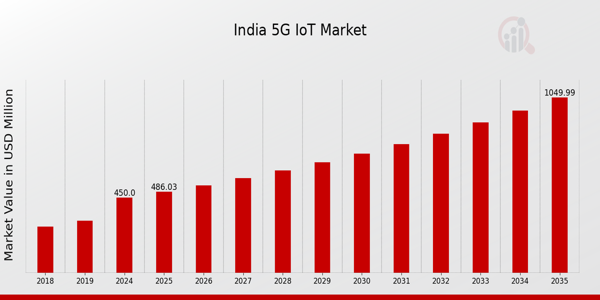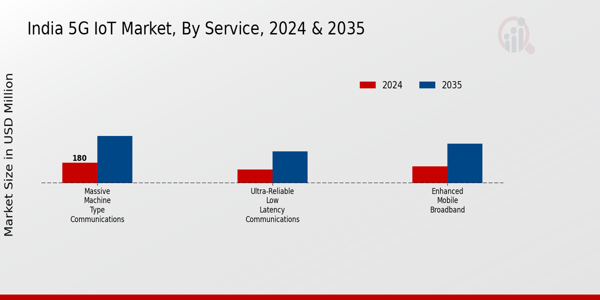India 5G IoT Market Overview
As per MRFR analysis, the India 5G IoT Market Size was estimated at 404.77 (USD Million) in 2023.The India 5G IoT Market Industry is expected to grow from 450(USD Million) in 2024 to 1,050 (USD Million) by 2035. The India 5G IoT Market CAGR (growth rate) is expected to be around 8.007% during the forecast period (2025 - 2035).
Key India 5G IoT Market Trends Highlighted
Various sectors, such as agriculture, healthcare, and smart cities, are experiencing substantial trends in the India 5G IoT market, which is being driven by the increasing adoption of digital technologies. Key market drivers, such as the government's emphasis on digital transformation through initiatives such as Digital India and the promotion of smart city development, facilitate advancements in infrastructure and regulatory support.
It is anticipated that the introduction of 5G technology will significantly improve connectivity and enable the functionality of IoT devices, thereby increasing efficiency and generating new applications.
In addition, the demand for smart devices and applications in automation, surveillance, and real-time data monitoring is on the rise, creating growth opportunities for industry participants to capitalize on this emerging market.
Recent trends suggest a substantial increase in the number of collaborations between technology companies and telecommunications operators to create innovative solutions that are specifically designed for Indian consumers and businesses.
The IoT sector is experiencing a trend toward customization, as evidenced by the increasing prevalence of localized solutions that are specifically engineered to address regional challenges. Investments in research and development that concentrate on 5G-enabled IoT solutions are essential for Indian companies to remain competitive in the global market.
In addition, the government's ongoing initiative to enhance connectivity in rural areas offers a chance to expand and introduce transformative technologies to underserved populations. India's industries will likely be redefined by the convergence of 5G and IoT, which will promote growth and improve the quality of life for its citizens.

India 5G IoT Market Drivers
Rapid Digital Transformation Initiatives
India is experiencing a significant wave of digital transformation across various sectors, driven by government initiatives like Digital India. The program aims to transform India into a digitally empowered society and knowledge economy.
As per government reports, over 50% of the Indian population is expected to be digitally literate by 2025, resulting in increased demand for advanced connectivity solutions like 5G Internet of Things (IoT).
This surge in digital adoption is anticipated to fuel the India 5G IoT Market Industry as businesses and consumers look to leverage connected devices for improved efficiency and productivity.
Established organizations such as Reliance Jio and Bharti Airtel are investing heavily in 5G infrastructure, and their initiatives are expected to bolster connectivity options, enabling seamless IoT applications across industries such as manufacturing, healthcare, and agriculture.
The rapid deployment of 5G technology will, therefore, catalyze the growth of the IoT ecosystem, enhancing operational capabilities and customer experience in the Indian market.
Government Policy Support
The government of India has been actively promoting the adoption of 5G technology through various policy initiatives. The National Digital Communications Policy (NDCP) 2018 aims to attract investments worth USD 100 billion in the telecom sector by 2025.
This strategic vision encourages the integration of 5G technology with IoT across various sectors, fostering innovative solutions and services. The push for 5G adoption has been further reinforced by the Indian Telecommunications Regulatory Authority's commitment to auctioning the 5G spectrum, expected to provide a significant boost to the India 5G IoT Market Industry.
With major telecom players like Vodafone Idea and BSNL entering the 5G space, this robust policy framework supports technological advancements and promotes growth within the IoT landscape.
Increased Demand for Smart Cities
The Smart Cities Mission, initiated by the Government of India, aims to develop 100 cities across the country by enhancing urban infrastructure and promoting technology integration.
By 2030, India is projected to have approximately 600 million people living in urban areas, thereby increasing the need for smart solutions that improve urban living.
The incorporation of 5G technology within these smart cities will allow for real-time monitoring, traffic management, and waste management through IoT applications.
Companies like Cisco and Siemens are actively collaborating with local authorities to implement smart city solutions in India, driving the growth of the India 5G IoT Market Industry.
The escalating number of smart city projects highlights the significant potential for IoT development, as it is estimated that cities can leverage connected devices to enhance service delivery by up to 30%, marking a substantial contributor to the overall market growth.
India 5G IoT Market Segment Insights
5G IoT Market Service Insights
The India 5G IoT Market is witnessing a transformative phase centered around the Service segment, which is essential for leveraging the full potential of advanced connectivity offered by 5G technology. As the nation progresses toward a digital economy, the demand for robust connectivity solutions becomes paramount, making this segment a pivotal area within the India 5G IoT Market revenue streams.
With the government's emphasis on initiatives such as Digital India, there’s an increased focus on integrating enhanced mobile broadband to deliver faster data rates and improved user experiences across a variety of industries, including education, healthcare, and entertainment.
This segment is instrumental in supporting the rise of applications that require high bandwidth, enhancing the overall digital landscape and service accessibility across urban and rural regions alike.
The emergence of Ultra-Reliable Low Latency Communications is crucial as it addresses the critical need for real-time data exchange, particularly in sectors such as healthcare and autonomous systems.
This aspect is increasingly recognized by industries looking to implement innovative solutions, thereby driving significant advancements in service reliability and responsiveness. Its importance is significantly highlighted in sectors where delays could have critical implications, such as remote surgery or smart grid management.
Additionally, Massive Machine Type Communications underpins the continuous growth of the IoT ecosystem in India by enabling a vast number of devices to connect and communicate efficiently. This aspect of the service segment supports the increasing deployment of smart sensors and devices in various industries, including agriculture, manufacturing, and smart cities.
As the country embraces Industry 4.0, this service offers essential opportunities for automating processes and improving operational efficiencies.As the 5G infrastructure expands, the Service segment is expected to evolve further, driven by innovations and a growing ecosystem of IoT applications.
The integration of these services not only enhances user experiences but also plays a substantial role in fulfilling India’s vision of becoming a global leader in technology and digital transformation. Overall, the dynamics of this segment illustrate the interconnected growth and potential of the India 5G IoT Market, highlighting a significant transformation in how services are delivered across various sectors in the country.

5G IoT Market Technology Insights
The Technology segment of the India 5G IoT Market is poised for significant advancement, driven by the integration of innovative architectures such as 5G New Radio Standalone Architecture and 5G New Radio Non-Standalone Architecture.
The Standalone Architecture is crucial as it functions independently without reliance on existing 4G networks, thereby enabling groundbreaking advancements in low latency and high-speed connectivity, which are essential for emerging applications like autonomous vehicles and smart cities.
Conversely, the Non-Standalone Architecture serves as a bridge, allowing for a smoother transition from 4G to 5G, which is pivotal for industries that require immediate enhancements without complete overhauls of their infrastructure.
The combination of these architectures is addressing the growing demand for reliable, high-speed internet across diverse sectors, including health care, manufacturing, and smart agriculture.
As India embraces digital transformation, these technologies represent a major component in enhancing network efficiency and delivering optimal performance, underscoring their importance in achieving the broader objectives of the Digital India initiative.
5G IoT Market Type Insights
The India 5G IoT Market is experiencing notable growth, driven by an increasing demand for connectivity and intelligent device integration across various sectors. Within the Type segment, Short-Range IoT Devices and Wide-Range IoT Devices play crucial roles in enhancing operational efficiency and improving service delivery.
Short-Range IoT Devices, typically utilized in smart homes and small businesses, benefit from low power consumption and high-speed connectivity, making them essential for applications such as smart meters and wearables. Conversely, Wide-Range IoT Devices cater to industrial and agricultural sectors, enabling real-time monitoring and automation over larger distances.
This segment is significant as it contributes to advanced applications like smart agriculture and urban development, aligning with India's digital transformation initiatives.
The government's commitment to boosting the digital economy through various programs supports the proliferation of these devices. Consequently, the market is positioned to witness a transformation as these devices facilitate connectivity and data exchange, ultimately enhancing productivity and innovation within the Indian economy.
5G IoT Market Vertical Insights
The India 5G IoT Market is witnessing a significant transformation within the Vertical segment, driven by technological advancements and the growing demand for connectivity. As the country aims to establish itself as a digital powerhouse, sectors like Consumer Electronics and Automotive play a pivotal role in integrating 5G capabilities for improved performance and user experience.
The automotive industry, in particular, is focusing on smart mobility solutions, enhancing vehicle safety and efficiency through real-time data collection and analysis. Similarly, the Railway and Mining sectors are utilizing IoT solutions to optimize operations, enhance safety measures, and facilitate predictive maintenance.
Utilities are leveraging 5G technology for smart grid deployment, allowing for greater energy management and distribution efficiency. In Healthcare, the integration of 5G IoT applications, such as telemedicine and remote patient monitoring, is expected to improve patient care and access to services.
Agriculture is also experiencing a transformation through precision farming, where IoT devices enable farmers to monitor soil conditions and crop health in real time, ultimately boosting yield.
Manufacturing is embracing automation and smart factories, where IoT devices enhance production efficiencies and reduce downtime. Overall, the diverse verticals in the India 5G IoT Market emphasize enhanced operational efficiencies, safety, and the drive towards a more connected future.
India 5G IoT Market Key Players and Competitive Insights
The India 5G IoT Market is witnessing rapid growth and competition as various players strive to establish their dominance in this emerging sector. As the demand for high-speed connectivity and advanced IoT solutions surges across industries, several key companies are investing heavily in research and development, partnerships, and infrastructure to enhance their offerings.
Competitive insights reveal that companies are not merely focusing on hardware and software solutions but are also leveraging data analytics, machine learning, and cloud capabilities to provide comprehensive IoT applications that meet the diverse needs of businesses in India.
The push for smart cities automated solutions in agriculture, healthcare, and industrial IoT is attracting investments from both domestic and international companies, reinforcing the importance of strategic alliances and technological advancements in this highly competitive landscape.
Qualcomm, a prominent player in the India 5G IoT Market, is focused on providing innovative solutions that cater to the burgeoning demand for the 5G IoT ecosystem. The company benefits from its robust portfolio of semiconductor products and wireless technology expertise, which positions it as a leader in enabling next-generation connectivity and device performance.
Qualcomm's strengths lie in its ability to deliver high-performance chipsets that support multiple IoT applications, including smart cities, autonomous vehicles, and connected devices.
Additionally, Qualcomm has a strong presence in the Indian telecom and electronics markets, enabling it to form strategic partnerships with local telecom operators and original equipment manufacturers. This integration of telecommunications and IoT solutions bolsters Qualcomm's competitiveness and ensures its offerings align with the unique requirements of the Indian market.
Tech Mahindra plays a vital role in the India 5G IoT Market by delivering a comprehensive suite of services tailored for various industry verticals.
The company focuses on providing end-to-end solutions that encompass IoT device management, analytics, and application development, catering to sectors such as manufacturing, healthcare, and smart transportation.
Tech Mahindra’s key products include solutions for asset tracking, smart homes, and industrial automation, reinforcing its reputation as an innovative technology provider.
The company's strengths are further highlighted by its strategic mergers and acquisitions, which facilitate the enhancement of its technological capabilities and market reach.
With an extensive network of partnership ecosystems, Tech Mahindra leverages collaborations with technology giants and startups alike to enhance its service offerings in India. The firm’s commitment to digital transformation and IoT integration establishes it as a noteworthy competitor in the thriving landscape of the India 5G IoT Market.
Key Companies in the India 5G IoT Market Include
- Qualcomm
- Tech Mahindra
- Reliance Industries
- Cisco
- Wipro
- Nokia
- Huawei
- Samsung
- HCL Technologies
- Tata Consultancy Services
- Bharti Airtel
- Ericsson
- IBM
- Vodafone Idea
India 5G IoT Market Industry Developments
The India 5G Internet of Things (IoT) market continues to thrive, with significant developments highlighting its growth.
In September 2023, Bharti Airtel announced its partnership with Ericsson to enhance 5G coverage across major Indian urban centers, potentially impacting thousands of IoT devices. Similarly, Tata Consultancy Services and Qualcomm have been collaborating on solutions aimed at advancing smart city initiatives utilizing 5G technology.
Samsung is also extending its 5G footprint, with plans to provide private network solutions specifically designed for industrial IoT applications. Major companies like Reliance Industries and Huawei are investing heavily in Research and Development for next-generation technologies, further promoting IoT integration across various sectors.
A notable merger in December 2022 involved Cisco acquiring a software solutions startup, strengthening its presence in the Indian market. Furthermore, the Indian government’s push for the Digital India initiative is supporting the deployment of 5G infrastructure, promising a boost for companies such as Wipro and Nokia as they expand their offerings in 5G-enabled IoT solutions.
The growing competitiveness and investments in this sector showcase how the India 5G IoT market is evolving rapidly, driven by innovation and strategic collaborations.
India 5G IoT Market Segmentation Insights
5G IoT Market Service Outlook
- Enhanced Mobile Broadband
- Ultra-Reliable Low Latency Communications
- Massive Machine Type Communications
5G IoT Market Technology Outlook
- 5G New Radio Standalone Architecture
- 5G New Radio Non-Standalone Architecture
5G IoT Market Type Outlook
- Short-Range IoT Devices
- Wide-Range IoT Devices
5G IoT Market Vertical Outlook
- Consumer Electronics
- Automotive
- Railway
- Mining
- Utilities
- Healthcare
- Agriculture
- Manufacturing
| Report Attribute/Metric Source: |
Details |
| MARKET SIZE 2023 |
404.77(USD Million) |
| MARKET SIZE 2024 |
450.0(USD Million) |
| MARKET SIZE 2035 |
1050.0(USD Million) |
| COMPOUND ANNUAL GROWTH RATE (CAGR) |
8.007% (2025 - 2035) |
| REPORT COVERAGE |
Revenue Forecast, Competitive Landscape, Growth Factors, and Trends |
| BASE YEAR |
2024 |
| MARKET FORECAST PERIOD |
2025 - 2035 |
| HISTORICAL DATA |
2019 - 2024 |
| MARKET FORECAST UNITS |
USD Million |
| KEY COMPANIES PROFILED |
Qualcomm, Tech Mahindra, Reliance Industries, Cisco, Wipro, Nokia, Huawei, Samsung, HCL Technologies, Tata Consultancy Services, Bharti Airtel, Ericsson, IBM, Vodafone Idea |
| SEGMENTS COVERED |
Service, Technology, Type, Vertical |
| KEY MARKET OPPORTUNITIES |
Smart cities infrastructure development, Industrial automation solutions, Enhanced healthcare services integration, Agriculture technology advancements, Automotive telematics and connectivity |
| KEY MARKET DYNAMICS |
Increased connectivity demand, Cost-effective IoT solutions, Government 5G initiatives, Smart city projects, Industrial automation growth |
| COUNTRIES COVERED |
India |
Frequently Asked Questions (FAQ) :
The India 5G IoT Market is expected to be valued at 450.0 million USD in 2024.
By 2035, the India 5G IoT Market is projected to reach a value of 1050.0 million USD.
The expected CAGR for the India 5G IoT Market from 2025 to 2035 is 8.007%.
The Enhanced Mobile Broadband service segment is anticipated to be the largest, valued at 350.0 million USD by 2035.
The Ultra-Reliable Low Latency Communications segment is valued at 120.0 million USD in 2024.
Key players in the India 5G IoT Market include Qualcomm, Tech Mahindra, and Reliance Industries among others.
The market size for the Massive Machine Type Communications segment is expected to reach 420.0 million USD by 2035.
Key growth drivers include increased demand for connectivity and advancements in IoT technologies.
Technological advancements are expected to significantly enhance the capabilities and applications within the India 5G IoT Market by 2035.
Intense competition among major players is likely to drive innovation and reduce prices in the India 5G IoT Market.
















